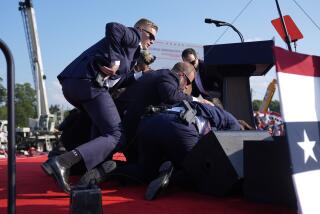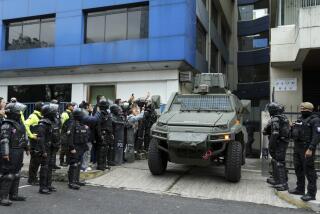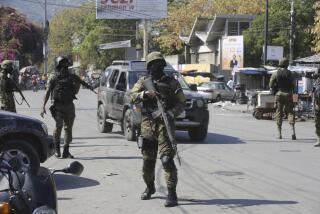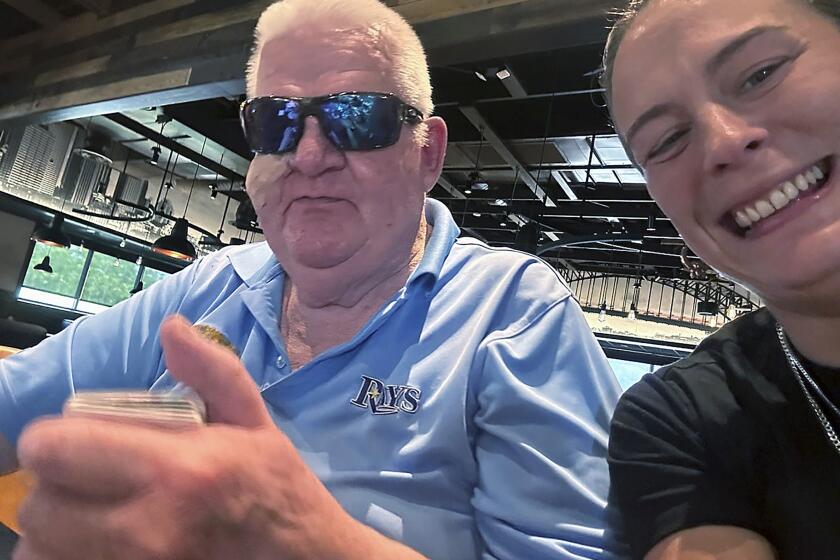New Botswana Embassy Not a Pretty Sight : High-Security Measures Turn the Building Into ‘Medieval Fortress’
GABORONE, Botswana — Even the Americans imported to look at it for a living admit that it is not a pretty sight--or site.
“Those arrow-slit windows kind of remind me of a medieval fortress,” said Warren Charlton, an agent with the State Department’s Bureau of Diplomatic Security.
Charlton is in charge of 12 CAGs, a U.S. government acronym for “cleared American guards.” They have been dispatched here to the dusty edge of the Kalahari Desert to watch the new American Embassy 24 hours a day for as long as it is under construction, estimated at nine more months.
In State Department lingo, they are attempting to ensure “total integrity against technical penetration over a 2-year period.”
Reaction to ’86 Law
The new embassy here is one of the first in the world constructed under strictures of the Omnibus Diplomatic and Anti-Terrorism Act of 1986. The bill was intended to reduce American vulnerability to electronic snooping, which compromised the U.S. Embassy in Moscow, and to terrorist attacks, such as one that which killed dozens of people at the U.S. Embassy in Beirut in April, 1983.
Security, under the new law, is not cheap.
The law almost doubles the price of any new embassy, according to Richard Dertadian, deputy assistant secretary for foreign building operations in the State Department.
Building the new embassy here, for example, will cost about $3.6 million, the State Department said, and surveillance during construction will cost an additional $3 million. The extra $3 million includes the cost of elaborate electronic security devices and the guards who operate and monitor them.
$115,000 Per Guard
Including salaries, housing and transport, each of the 75 cleared American guards posted at 18 construction sites around the world costs the government about $115,000 a year, the State Department estimates.
Gaborone, capital of a landlocked southern African country with 1 million people, 2 million cows and a history of friendship with the United States, hardly seems a hot spot for espionage or anti-American terrorism.
“It is not a high-threat post,” Dertadian said. But the law is the law.
Three years ago, a commission headed by retired Navy Adm. Bobby Inman found that most American embassies do not meet minimum security standards. In response, Congress authorized $2.1 billion to be spent over five years. The American Academy of Sciences advised the State Department on how to build and safeguard foreign diplomatic missions, and architects, thinking “blast resistance,” rushed to drawing boards.
New, Uglifying Standards
All new embassies must meet the new and, in the case of the Gaborone embassy, uglifying standards.
The design motif here is bomb survival. Accordingly, the building has the architectural niceties of a tank.
“The building is over-built. It is damn near incredible,” said Michael Carter, the State Department’s regional security officer in Botswana.
The pillbox-like embassy has thick concrete walls poured around high tensile-strength steel reinforcing bars placed closely together. The thickness of the concrete and proximity of the bars are classified.
‘Nonoperable’ Windows
The arrow-slit windows have anti-blast glazing and are “nonoperable,” meaning that they do not open. Sunlight will be as scarce in the new building as night life in Gaborone. Security considerations “have substantially reduced the amount of window space we can have,” said Dertadian, who monitors foreign building operations from his office in Washington.
Encircling the embassy and giving it at least 100 feet of “stand-off distance” is another formidable structure--the anti-ram perimeter wall. Nine feet high, 20 inches thick and topped with steel spikes, it is anchored, iceberg fashion, to a 4-foot-wide reinforced concrete foundation.
Nine television cameras on towers around the construction site scrutinize this steel and concrete as it comes together here in one of the world’s sleepiest capitals. The cameras feed into six monitors in the Access Control Center, where Americans--under the Omnibus Security Act, they must be Americans--are posted night and day.
Usually, they watch Botswana construction workers hammering nails, pouring cement and, since this is a very hot place, sweating.
6-to-1 Ratio
“We like to keep it at about six local construction persons to one surveillance person,” Carter said. “We think it can be done. But all the training in the world won’t allow the Americans to look in six different directions at the same time.”
In case the Americans miss something, the construction site also is equipped with a microwave alarm system that can detect unauthorized movements. In addition, each construction worker must pass through a metal detector on the way to and from the site.
One of the Americans who watches the television monitors is Thomas Munk, 27, of Reston, Va. He is a former Marine guard who served in Beirut in 1983, the year the embassy was bombed and the year in which 241 U.S. servicemen were killed by a truck bomb at the Marine Corps headquarters compound at Beirut airport.
In Beirut, Munk said, the challenge was to stay alive. In Gaborone, where he is on contract to a private security firm, he said the challenge is to stay awake.
S. African Commando Raids
“Granted, the threat here in terms of hostile mobs, in terms of war, is a lot less than some other places,” Carter said. “However, we wouldn’t have put this all in place if there weren’t some degree of threat.”
Gaborone has been the target of several raids by South African commandos, seeking to kill and scare away members of the anti-apartheid African National Congress. The most recent attack, in which four persons were killed, occurred March 28 in a northern suburb of the capital.
A U.S. official here said the South Africans have an “aggressive intelligence operation in Gaborone. It is not unknown for them to target us.” Without referring to a specific country, the official said, “We have detected an interest here in our building, in what and how we are building it and how we are safeguarding it.”
The common reaction of first-time viewers is that the new embassy here is grimly boxlike and ugly. At the State Department in Washington, Dertadian acknowledged the homeliness factor.
Tacked-On Gimmicks
He said that the embassy was built according to a design that predates the anti-terrorism act and that the new security gimcracks were simply tacked on. Limited consideration, he said, could be given to aesthetics. None of the 17 other diplomatic security projects now under way around the world is likely to be so ugly, he said.
“When architects start from scratch, they have been able to deal in some pretty interesting ways with the design challenge and aesthetics,” said Dertadian. He cited new embassies under construction in Bangladesh, Honduras and Guyana as more attractive buildings.
“Considering what they are up against,” he said, “architects can do a lot with landscaping, with interior space, atriums and stone.”
When construction is complete here in December, Gaborone will have the most secure U.S. embassy in sub-Saharan Africa. It will represent a quantum improvement over the current embassy, located above a clothing store on the second floor of an aging downtown office building.
Despite more than $6 million in security spending, this capital still has a potentially disastrous security leak. That is in a suburban residential neighborhood. Gaborone is the only city in the world where the American ambassador lives next door to the Soviet ambassador.
“Our ambassador must have a better security awareness than perhaps any other,” Carter said. “Anyway, he is planning to move.”
More to Read
Sign up for Essential California
The most important California stories and recommendations in your inbox every morning.
You may occasionally receive promotional content from the Los Angeles Times.










